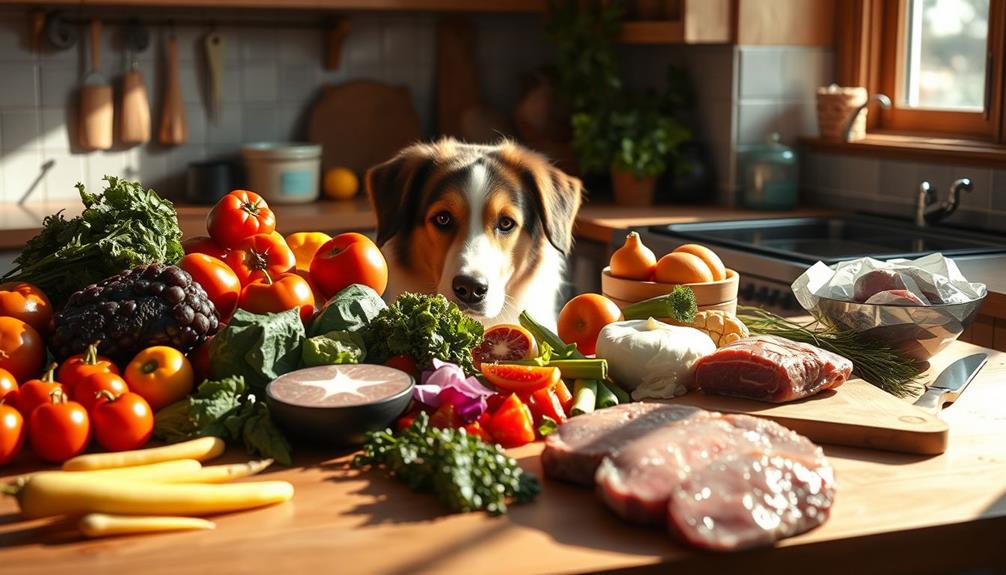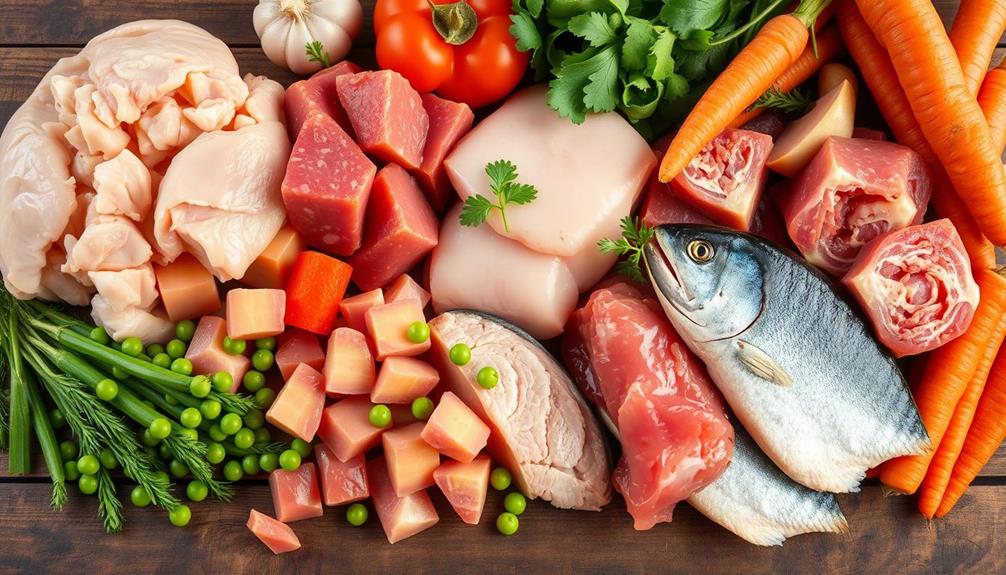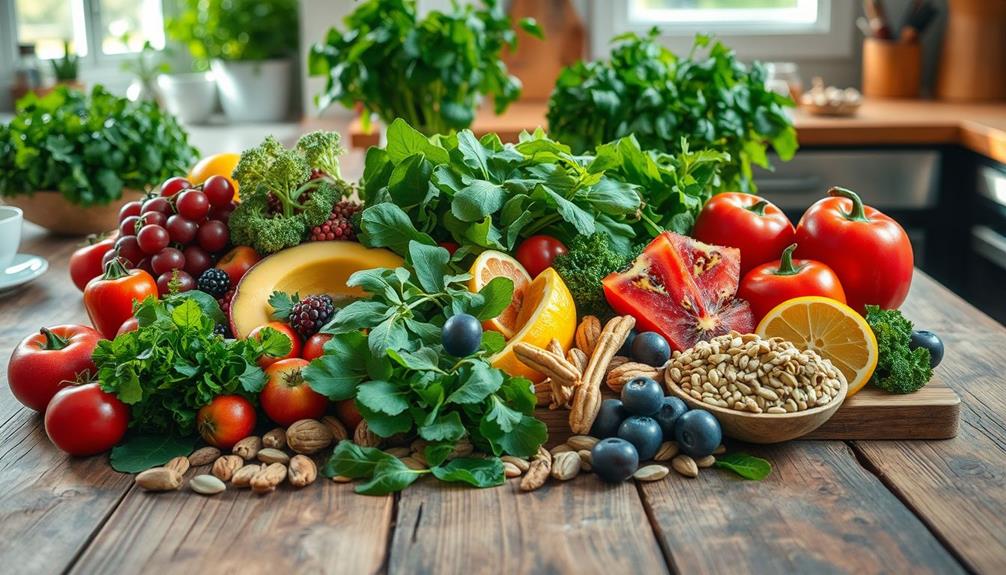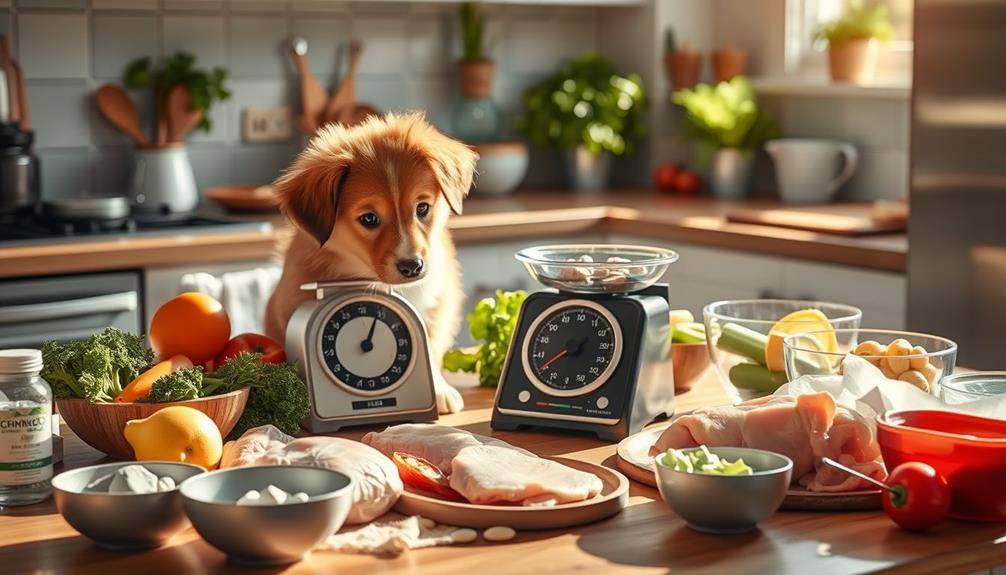Yes, your dog can eat raw food, but there are important factors you should consider first. Raw diets may offer higher quality ingredients and potential benefits like improved energy and coat condition. However, they also pose serious health risks, including bacterial contamination and nutritional deficiencies. It's vital to handle raw food safely and guarantee it's well-balanced to prevent health issues for your dog. Consulting a veterinarian can help you navigate this dietary change. If you want to uncover more details about raw feeding practices and safety, stick around for further insights on making the best choice for your pup. Some pet owners have reported that raw food diets have helped reduce the frequency and severity of their dog’s seizures. However, it’s important to note that this anecdotal evidence is not a substitute for professional veterinary advice. Before making any changes to your dog’s diet, it’s crucial to consult with a veterinarian to ensure that you are making the best decision for your pet’s health and well-being. Additionally, understanding the potential risks and benefits of raw food and dog seizures can help you make an informed decision about your dog’s diet.
Key Takeaways
- Raw dog food can provide higher quality ingredients and improved coat health, but it carries risks like bacterial contamination and nutritional deficiencies.
- Consult a veterinarian or pet nutritionist to ensure a balanced raw diet, as unbalanced diets can lead to serious health issues.
- Handle raw food with care to prevent cross-contamination; wash hands and surfaces thoroughly after preparation.
- Monitor your dog for choking hazards when feeding raw bones or meat, especially for small breeds or puppies.
- Transition to a raw diet gradually, observing for any adverse reactions during the process.
Understanding Raw Dog Food
Understanding raw dog food involves recognizing its components and the philosophy behind it. This diet typically consists of uncooked meat, bones, organs, and sometimes fruits and vegetables, designed to mimic what wild canines would naturally eat. Popularized by veterinarian Ian Billinghurst in 1993, it's often referred to as the BARF diet (Bones and Raw Food). Many pet owners seek alternatives to traditional kibble, looking for options that provide nutritional insights into their pets' dietary needs.
While some dog owners believe that feeding raw can lead to improvements in coat quality and energy levels, these claims lack solid clinical backing. It's crucial to be aware of the health risks associated with raw dog food, as the CDC and FDA warn about potential bacterial contamination. Nearly 25% of raw samples test positive for harmful pathogens like Salmonella and Listeria, which can affect both pets and their owners.
Moreover, achieving a balanced diet can be challenging when feeding raw. Nutritional deficiencies can arise if the diet isn't carefully planned. Consulting a vet nutritionist is strongly recommended to guarantee your dog's nutritional needs are met without compromising their health.
Weighing the pros and cons will help you make an informed decision about whether raw meat is good for your dog.
Benefits of a Raw Diet
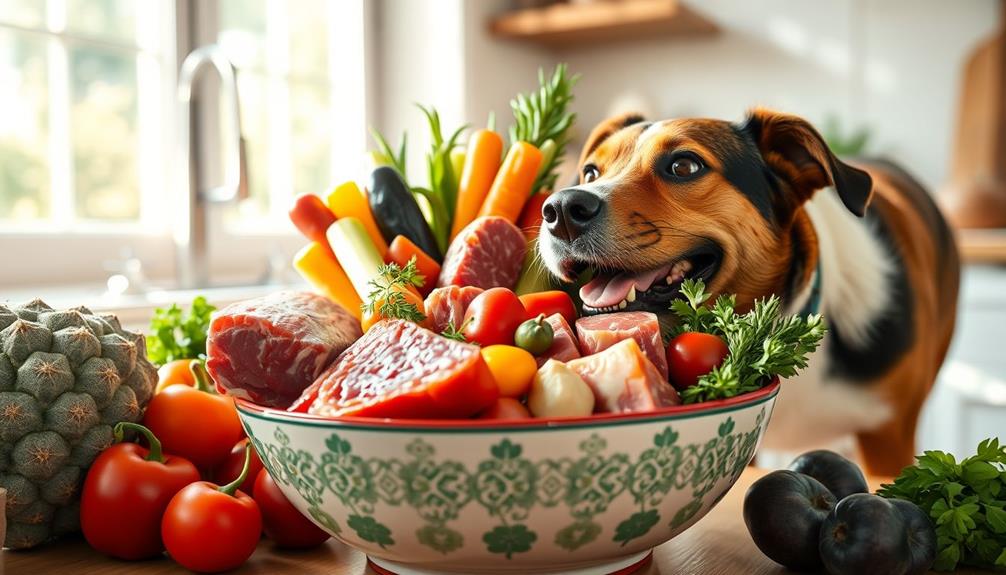
A raw diet can offer your dog significant nutritional advantages, as it typically contains higher quality ingredients without the fillers found in processed kibble.
Incorporating high-quality protein sources can enhance your dog's energy levels and overall vigor. This can lead to improved digestion, helping your dog absorb nutrients more effectively.
Many owners notice these benefits manifest as increased energy and overall better health in their pets.
Nutritional Advantages
Among the many benefits of a raw diet for your dog, improved coat health and skin condition often stand out. When dogs eat raw, they receive moisture and healthy fats that promote healthier skin and a shiny coat.
A veterinary nutritionist would tell you that these raw food diets can offer significant health benefits compared to traditional balanced dog food. Additionally, raw diets can contain natural antioxidants, which may contribute to overall health, similarly to the benefits of cranberry juice consumption.
Many owners notice increased energy levels in their pets after switching to raw diets, likely due to the absence of indigestible carbohydrates found in processed foods. This boost in liveliness can enhance your dog's overall happiness and satisfaction at mealtime.
Additionally, the act of chewing raw meat and recreational bones can improve dental health. The natural crunch helps reduce plaque and tartar buildup, promoting better oral hygiene.
Improved Digestion
When you switch your dog to a raw food diet, you might notice significant improvements in digestion. Raw food diets eliminate the indigestible carbohydrates found in kibble, resulting in smaller, firmer stools. This change can help your dog feel more comfortable and reduce the frequency of digestive issues.
The natural ingredients in raw diets are less processed, which enhances nutrient absorption and aligns better with your dog's evolutionary needs. Additionally, considering the importance of selecting the right cold medication can also be beneficial for overall health, as a well-balanced diet contributes to a stronger immune system.
The high moisture content in raw food promotes better hydration, further aiding digestion and potentially reducing the risk of constipation. Many dog owners report that their pets show increased energy and liveliness after shifting to raw food, thanks to better nutrient availability.
Additionally, chewing raw meat and bones contributes to improved dental health, which plays a significant role in digestion. This activity promotes salivation and helps break down food more effectively.
Health Risks to Consider
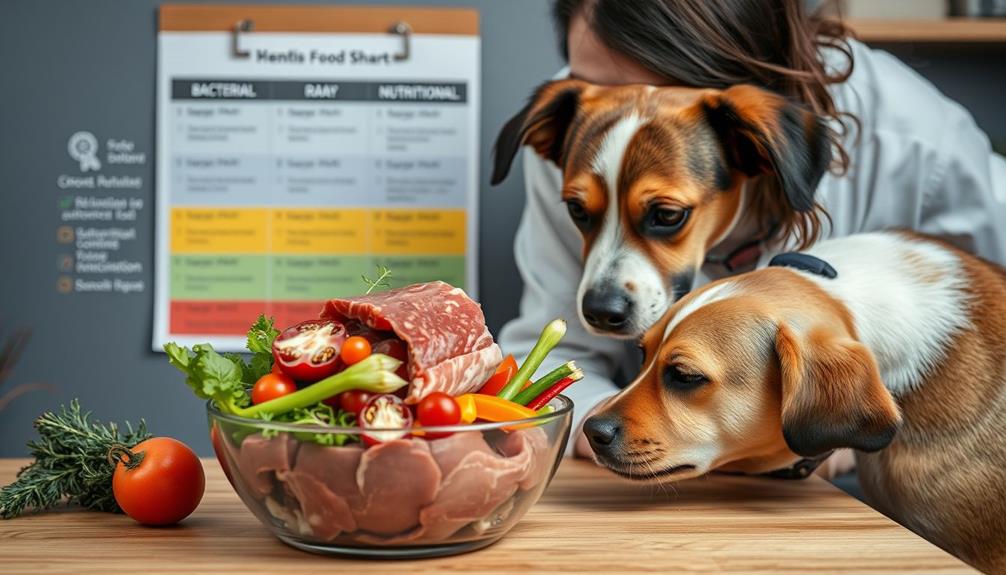
When considering a raw food diet for your dog, it's essential to weigh the potential health risks involved.
emotional dysregulation can affect decision-making, leading to impulsive choices regarding your pet's nutrition.
Bacterial contamination, nutritional deficiencies, and choking hazards can all pose serious threats to your pet's well-being.
Understanding these risks can help you make a more informed decision about your dog's diet.
Bacterial Contamination Risks
Feeding your dog raw food might seem like a natural choice, but it comes with significant risks, especially concerning bacterial contamination. Nearly 25% of raw food samples tested positive for harmful bacteria, including Salmonella and Listeria monocytogenes. These bacteria pose serious health risks not just to your dog, but to you as well.
Here's a quick overview of the bacterial risks associated with raw dog food:
| Bacteria | Health Risks |
|---|---|
| Salmonella | Fever, diarrhea, vomiting; can spread to humans through contaminated surfaces. |
| Listeria monocytogenes | Severe consequences, especially for the immunocompromised; hospitalization in over 90% of cases. |
| Handling Raw | Improper handling can lead to cross-contamination in your kitchen. |
| Contaminated Surfaces | Dogs can carry bacteria without symptoms, spreading it to surfaces. |
| Proper Sanitation | Essential to minimize risks; wash hands and surfaces thoroughly after handling raw food. |
Nutritional Deficiencies Potential
Balancing your dog's raw food diet is vital to prevent nutritional deficiencies that can arise over time. Many raw food diets lack essential nutrients, particularly calcium and phosphorus, which can lead to serious health issues. Unlike commercially prepared dog food, homemade raw diets often fail to provide the necessary macro- and micro-nutrients. Proper budgeting and planning are essential for ensuring that your dog receives a balanced diet, just as having a solid personal budget is vital for financial health a solid personal budget.
The American Veterinary Medical Association warns that unbalanced raw diets may cause growth abnormalities in puppies, stemming from improper calcium-phosphorus ratios. Additionally, a study by Dr. Lisa M. Freeman shows that diets consisting solely of muscle meat, without organ meats and bones, can result in significant nutritional deficiencies.
Moreover, dogs on unbalanced raw diets might experience gastrointestinal issues. Abrupt dietary changes can disrupt their digestive systems, leading to further complications.
If you're considering a raw food diet, be sure to consult with a veterinarian or a pet nutrition expert. They can help you create a balanced meal plan that includes all the essential nutrients your dog needs for ideal health.
Choking Hazards Concerns
Choking hazards are a significant concern for dogs on raw food diets. When feeding your dog, it's vital to be cautious about the types of raw meat and whole bones you include. Whole bones can break into larger fragments, leading to potential choking or internal injuries if your dog tries to swallow them whole.
This risk is particularly heightened for puppies and smaller dog breeds, whose smaller throats make them more susceptible to choking on larger pieces of raw food. Additionally, incorporating important oils with calming effects, such as lavender oil, may help reduce anxiety during mealtime, making your dog more relaxed while eating.
You should always be on the lookout for signs of choking, such as gagging, coughing, or difficulty breathing. If you notice any of these signs, it's vital to seek immediate veterinary attention.
To minimize choking risks, provide appropriately sized raw food and avoid large or hard bones that might pose a danger during mealtime. Encouraging safe chewing habits can also help, so consider offering softer, smaller pieces of raw meat that are easier for your dog to manage.
Safety and Handling Practices
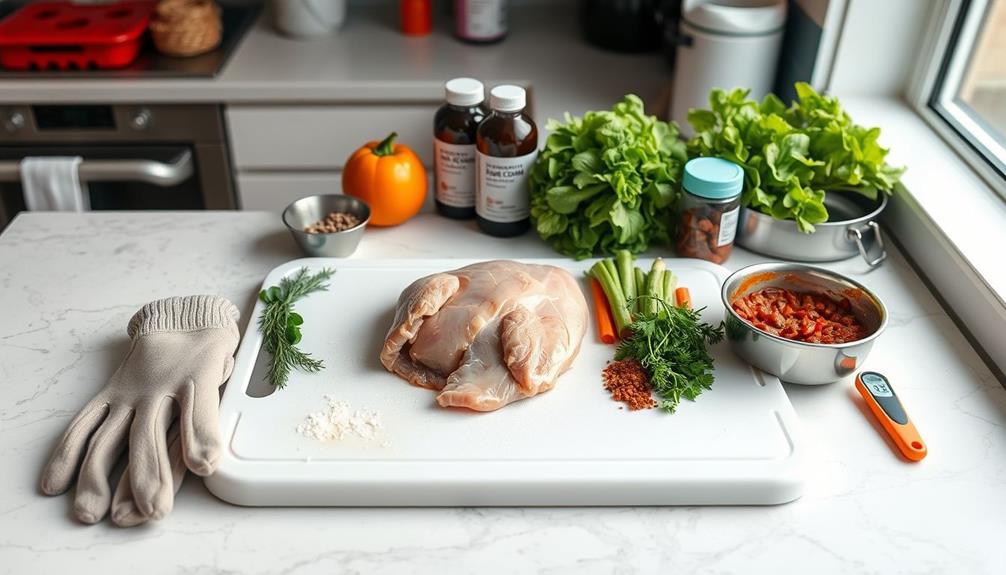
When it comes to raw dog food, safety and proper handling are vital to prevent health risks for both you and your pet. Always wash your hands thoroughly after handling raw food to avoid spreading harmful bacteria like Salmonella and Listeria. These bacteria can affect both dogs and humans, so take this seriously.
Regular cleaning of surfaces is important, as mechanic shops for fuel injection cleaning can highlight the significance of maintaining cleanliness to prevent contamination.
It's important to clean and disinfect surfaces that come into contact with raw dog food. Nearly 25% of raw food samples tested positive for harmful bacteria, posing significant health risks.
Store raw dog food in the freezer until you're ready to use it, and thaw it in the refrigerator or microwave to minimize bacterial growth and contamination.
Keep raw food separate from other food items. Use distinct dishes and storage containers for raw dog food to avoid cross-contamination.
Follow safe handling practices by covering leftovers appropriately. Consider using high-pressure processing (HPP) methods to neutralize pathogens without compromising the food's integrity.
Nutritional Balance and Alternatives
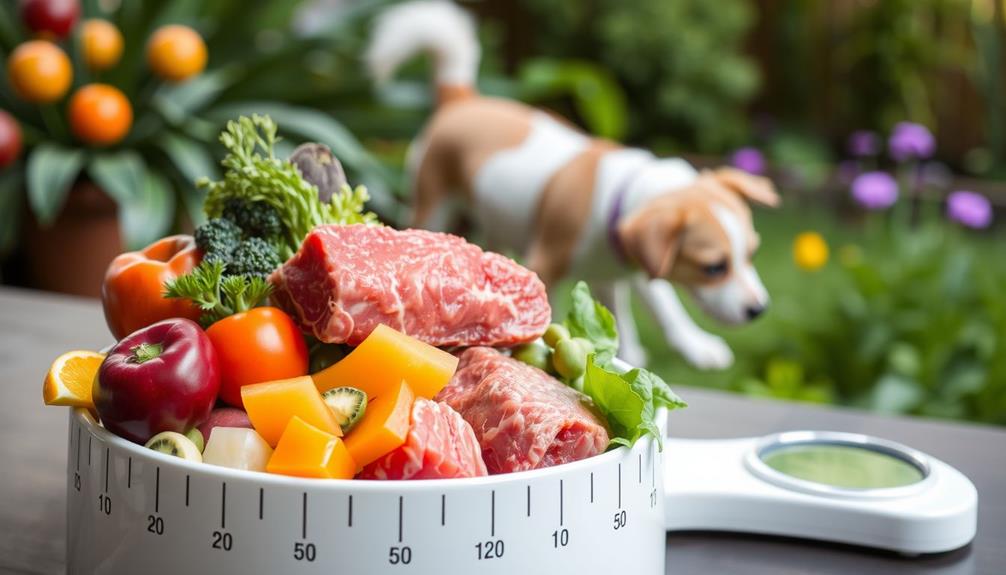
Guaranteeing your dog gets the right nutritional balance is essential for their overall health and well-being. A raw dog food diet might seem appealing, but it often leads to nutritional deficiencies. Without proper guidance, you risk creating an imbalanced diet that can cause severe health issues.
Additionally, just as with mastering the art of bug out bags, preparation and knowledge are key to guaranteeing your dog thrives on any diet you choose.
To maintain balanced nutrition for your dog, consider these points:
- Consult a veterinary nutritionist: They can help you formulate a raw diet that meets all your dog's nutritional needs while adhering to AAFCO standards.
- Choose commercially available options: These diets are specifically designed to provide complete and balanced nutrition, reducing the risks associated with homemade raw diets, such as bacterial contamination.
- Monitor your dog's health: Regular check-ups will help identify any potential health issues arising from nutritional deficiencies in their diet.
While a raw dog food diet can offer some benefits, the risks often outweigh them. Prioritizing balanced nutrition through professional guidance and quality commercial options will guarantee your furry friend stays healthy and happy.
Transitioning to Raw Food

Shifting your dog to a raw food diet requires careful planning to prevent any digestive upset. Start the change gradually by mixing 25% raw food with 75% of their current diet for the first three days. This slow approach helps minimize gastrointestinal upset and allows your dog's digestive system to adjust.
Additionally, as with any dietary change, monitoring your dog's overall health is vital, as key domains of development in psychology can influence how they adapt to new foods. After this initial phase, increase the mix to 50% raw and 50% old food for another three days. Then, move to a 75% raw and 25% old food combination for the next three days. By Day 10, your dog should be fully changed over to a raw food diet.
During this process, monitoring your dog for any adverse reactions is essential. Some dogs may experience digestive issues or changes in behavior, so keep an eye out for these signs.
You might also need to adjust feeding amounts based on your dog's activity level and life stage. A general guideline is to feed 2-3% of their body weight daily. Consulting with a veterinary nutritionist can provide tailored advice, ensuring that the new raw diet meets your dog's specific nutritional needs.
Veterinary Insights and Recommendations
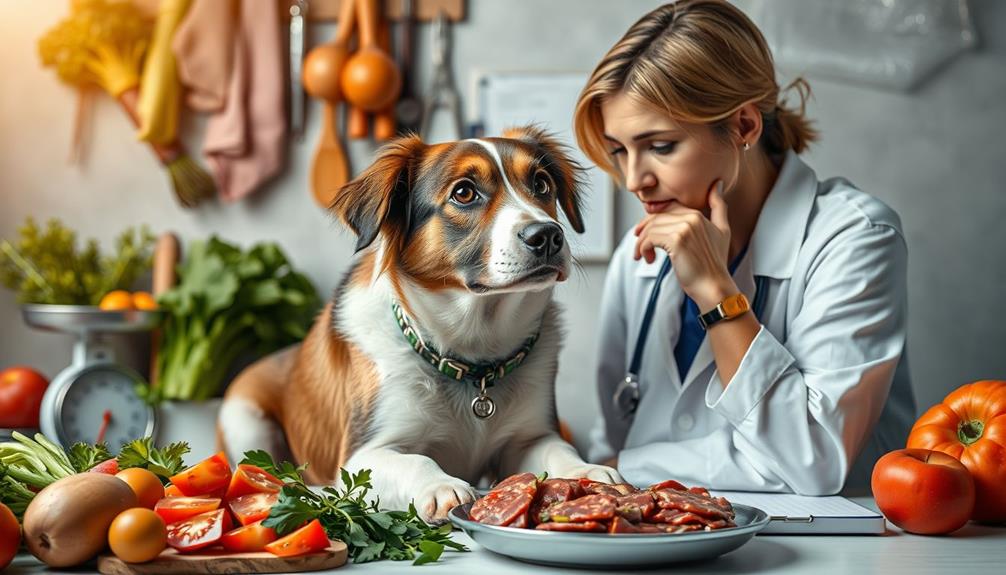
Veterinarians play an essential role in guiding dog owners through the complexities of diet choices, particularly when it comes to raw food.
While some may advocate for raw food diets, veterinary nutritionists caution against them due to potential health risks. They emphasize the importance of a balanced diet that meets AAFCO standards, which many commercial dog foods provide.
Here are three vital considerations when evaluating raw food diets:
- Nutritional Deficiencies: Raw diets can lead to imbalances unless carefully formulated, risking your dog's health.
- Harmful Bacteria: Studies reveal that raw meat may harbor harmful bacteria like Salmonella and Listeria monocytogenes, posing risks to both dogs and humans, especially vulnerable populations.
- Consult with a Veterinarian: Before making significant dietary changes, it's imperative to consult with a veterinarian. They can offer tailored advice and guarantee your dog's nutritional needs are met without exposing them to unnecessary health risks.
Frequently Asked Questions
How Do I Make Sure Raw Food Is Safe for My Dog?
To guarantee raw food's safe for your dog, wash hands thoroughly, store food properly, and keep it separate from other items. Consult a vet for balanced nutrition and monitor your dog for any health issues.
How Do I Know What Raw Food to Feed My Dog?
Choosing raw food for your dog's diet is like steering through a maze. You'll want to consult a vet, mix protein sources, guarantee balanced nutrients, and monitor their health to find what works best for them.
What Are the Guidelines for Raw Food Dogs?
When feeding your dog raw food, follow guidelines like starting with a gradual shift, offering 2-3% of their body weight daily, and ensuring proper handling to prevent contamination. Always monitor for any health changes.
What Is a Good Raw Food Diet for Dogs?
Crafting an enchanting raw regimen for your dog involves combining fresh meats, bones, and organs, ensuring balanced nutrition. Incorporate a variety of protein sources, and always prioritize safe storage and sanitation to safeguard your pup's health.
Conclusion
In the end, deciding if your dog should eat raw food is like maneuvering a winding road—you need to take into account the twists and turns carefully. Weigh the benefits against potential health risks and always prioritize safety. If you choose to make the switch, do it gradually to help your furry friend adjust. Consulting your vet will guide you on the best path, ensuring your pup stays happy and healthy on this new adventure!

